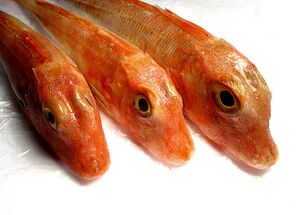
Gurnard, (sea robin or gurnet) are bottom-feeding scorpaeniform fishes in the family Triglidae. They get their name from their large pectoral fins, which, when swimming, open and close like a bird's wings in flight.
They are bottom dwelling fish, living at depths of up to 200 metres (660 ft). Most species are around 30 to 40 centimetres in length. They have an unusually solid skull, and many species also possess armoured plates on the body. Another distinctive feature is the presence of a "drumming muscle" that makes sounds by beating against the swim bladder.
Sea robins have six spiny "legs," three on each side. These legs are really flexible spines that were once part of the pectoral fin. Over time, the spines separated themselves from the rest of the fin, developing into feeler-like "forelegs." The pelvic fins have been thought to let the fish "walk" on the bottom, but are really used to stir up food. When caught, it makes a croaking noise similar to a frog. The first three rays of the pectoral fins are membrane free and used for chemoreception.
Sea Robin flesh is described as firm and tender when cooked. The fish serves as an adequate replacement to rascasse, or scorpionfish, in bouillabaisse.